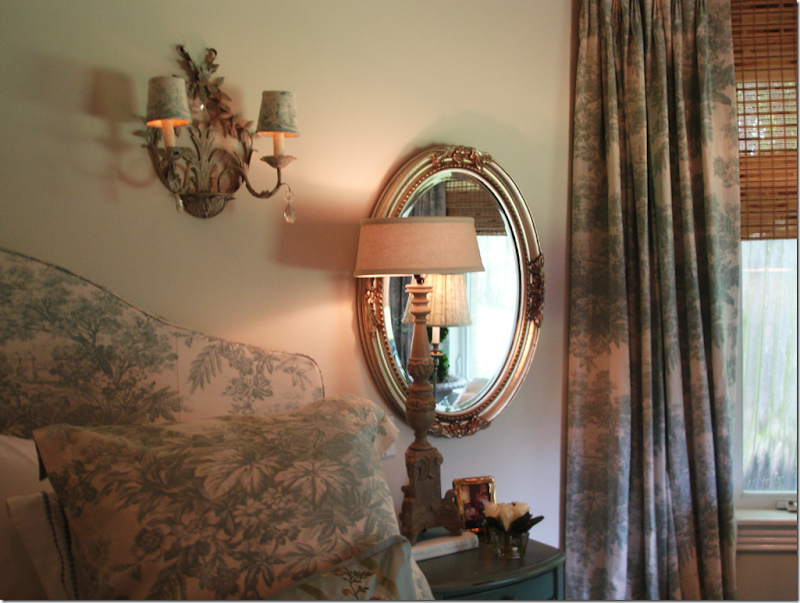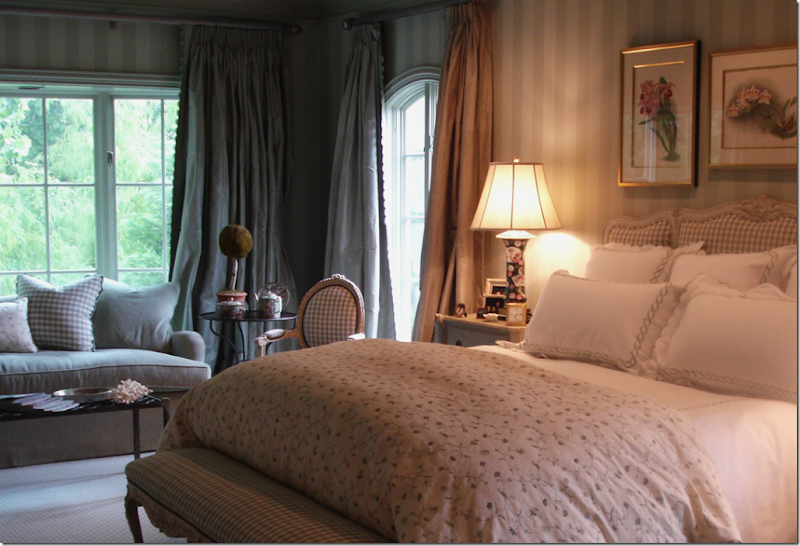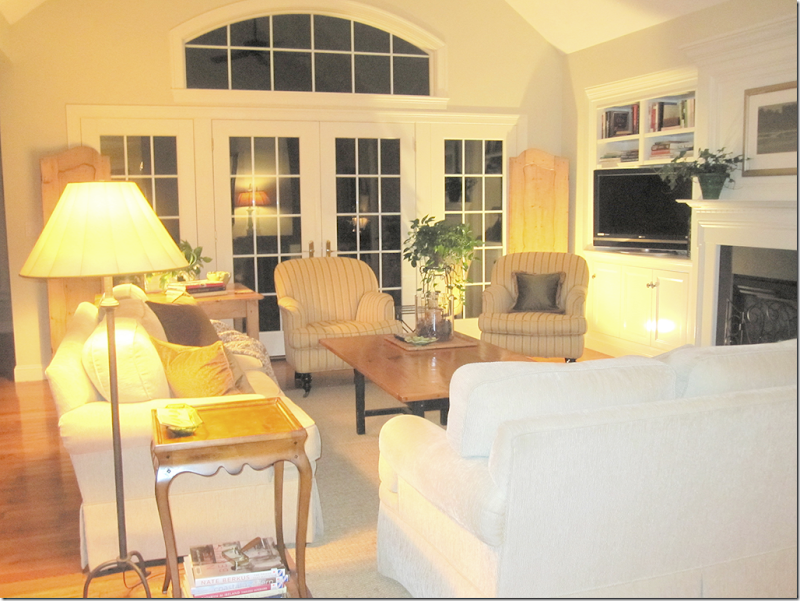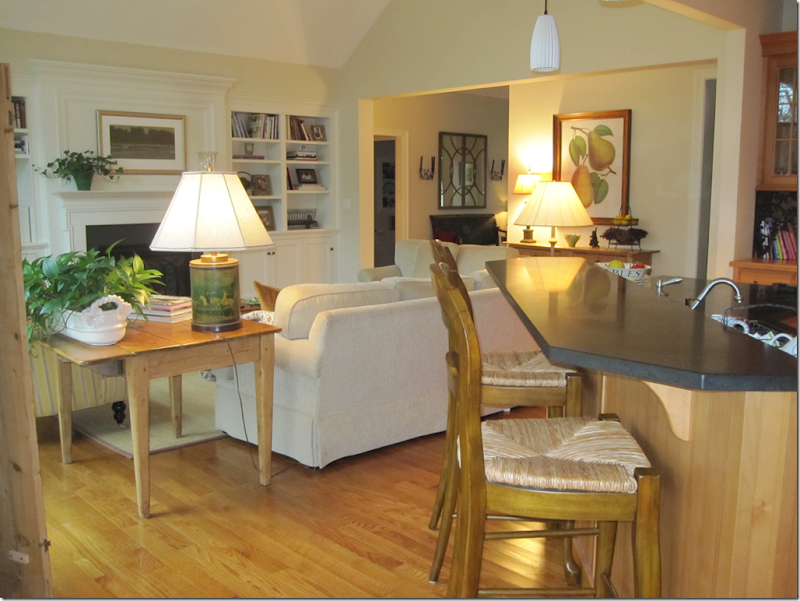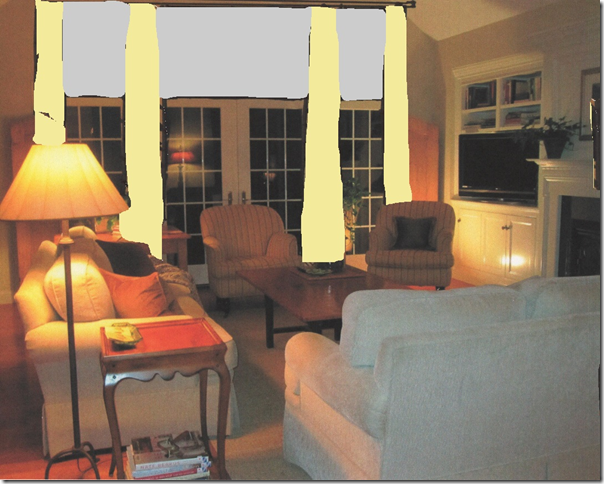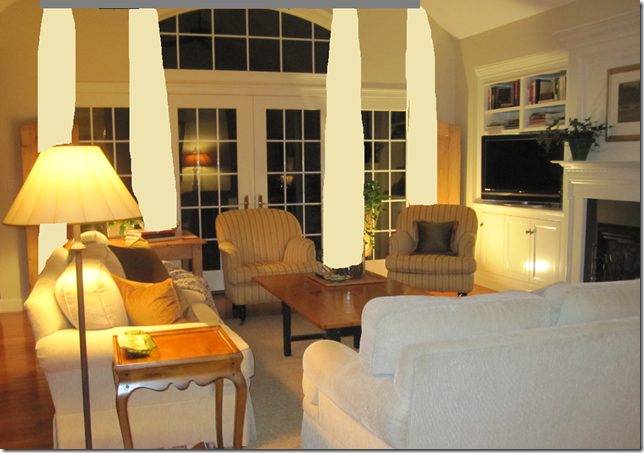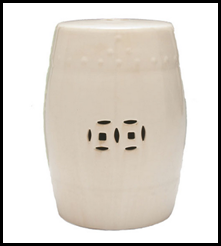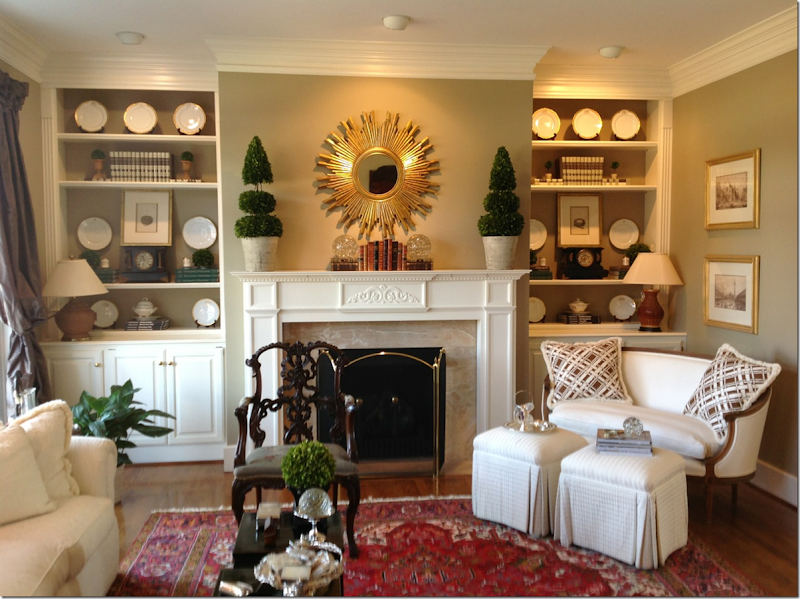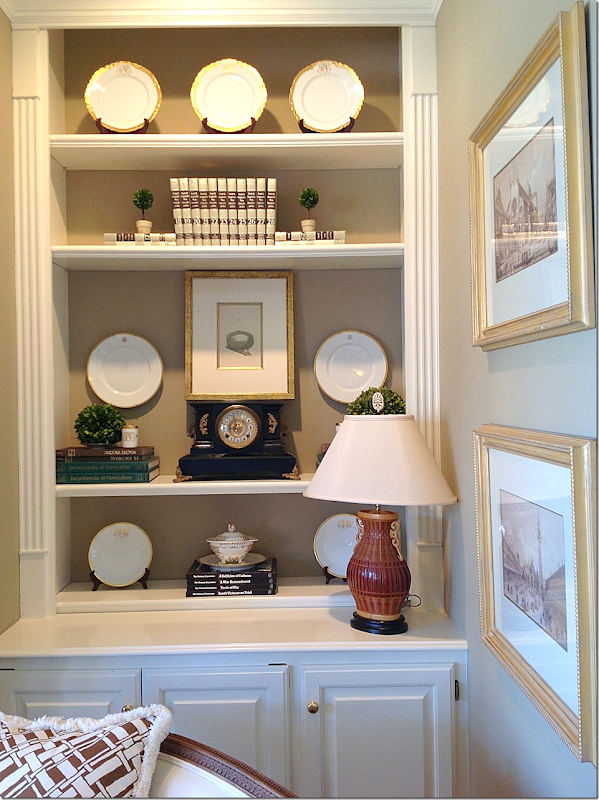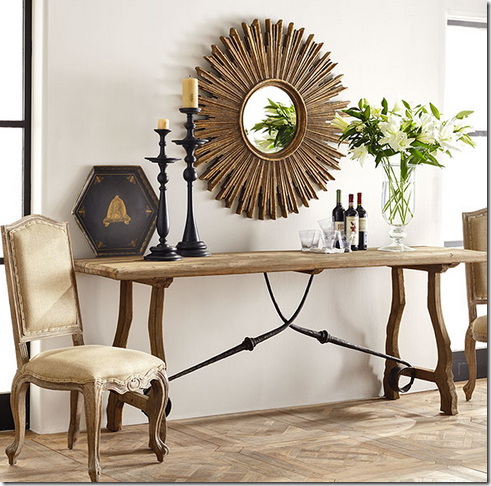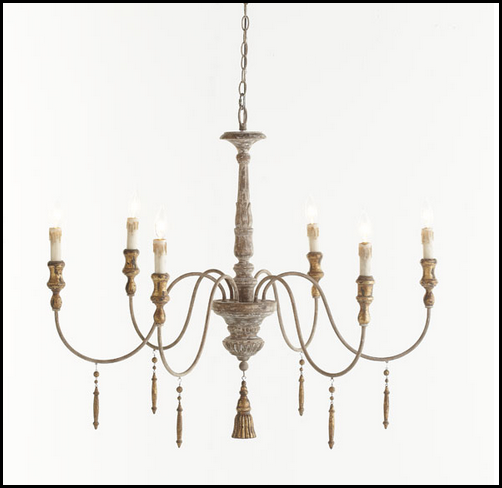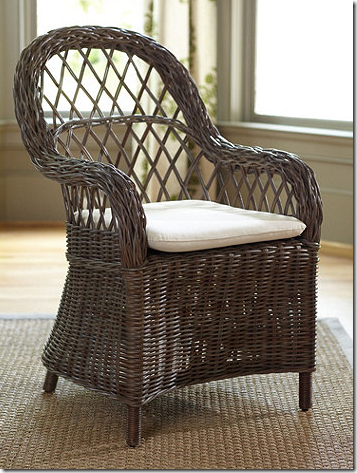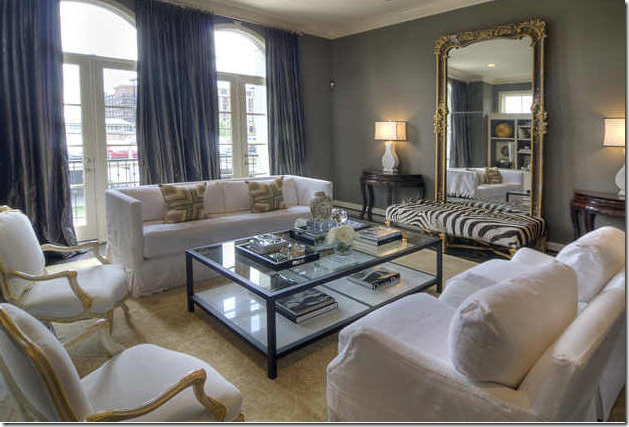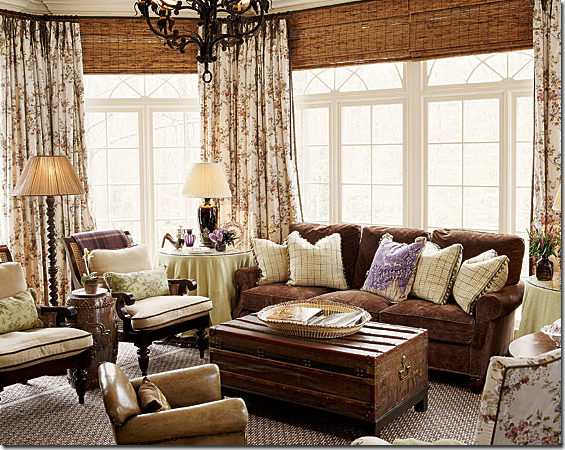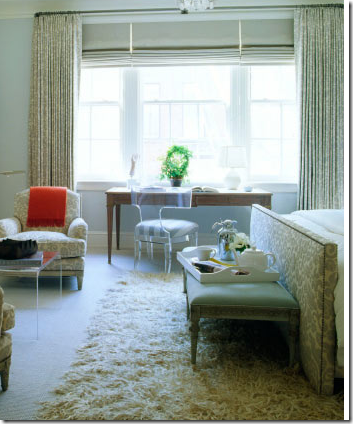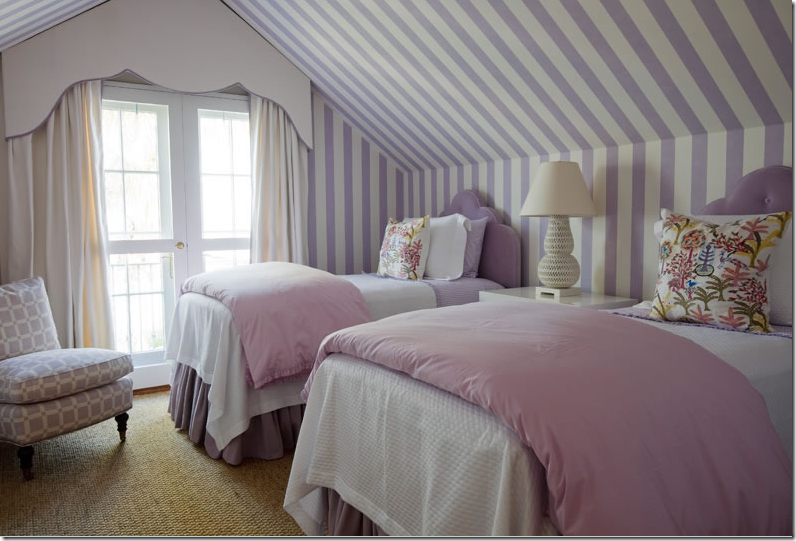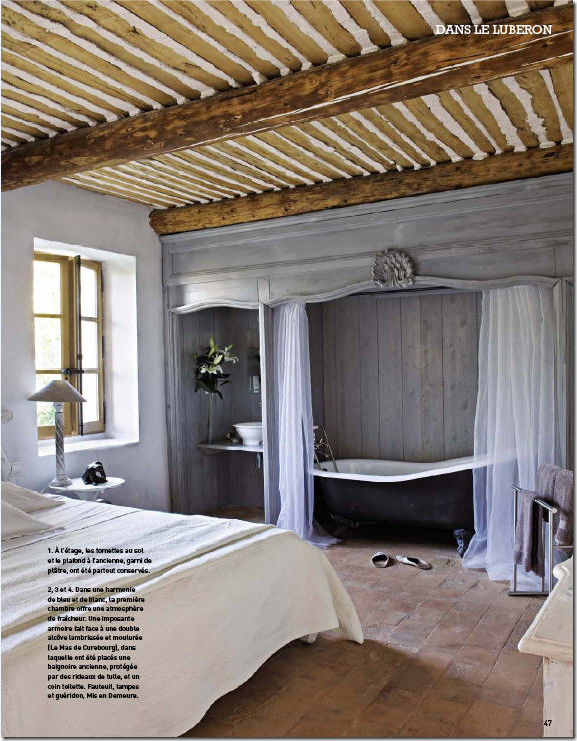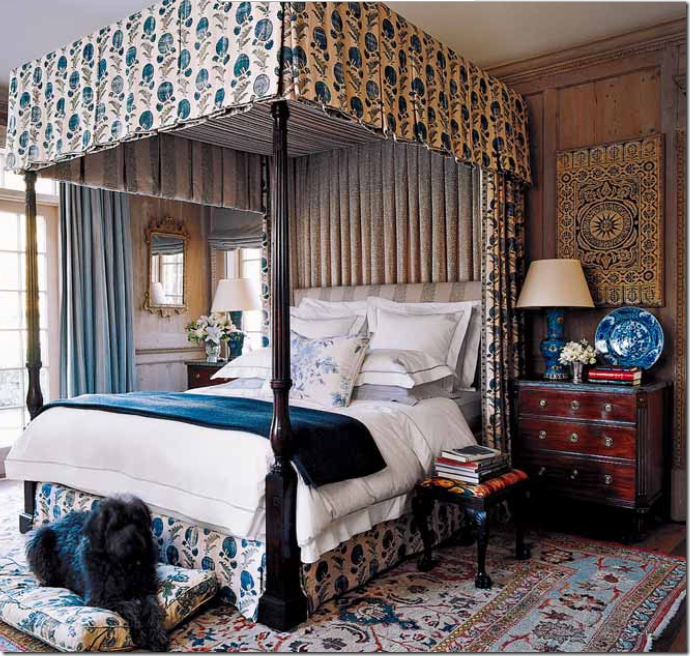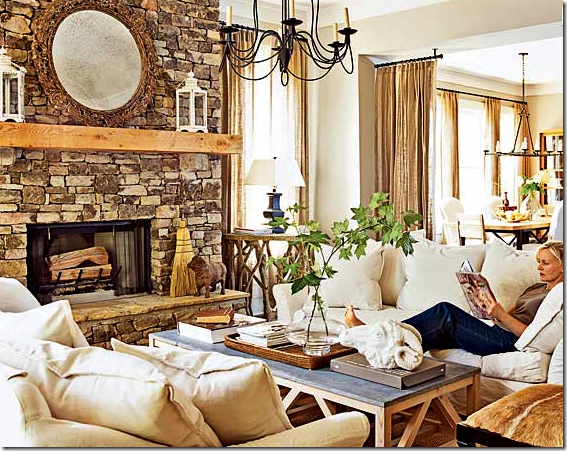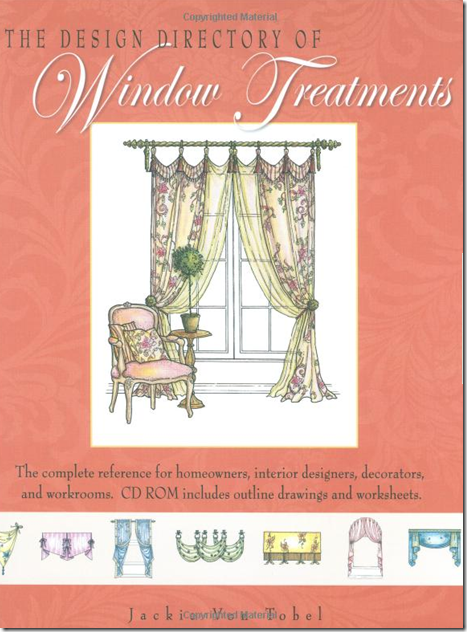1
Vermeer: Lady with her Maidservant
Dear Miss Cote de Texas: I would love your guidance on how to use color and texture effectively to create a focal point and maximize style in Great Room, Breakfast Room and Entry. I'm open to changing or adding color, introducing new fabrics & area rugs and slip covering yellow stripped chairs in GR.
This homeowner has a lot going for her already. She has nice furniture and accessories and a very pretty house. She just wants to pull it all together and get a more decorated look. In my opinion, the best way to get a “decorated” look is to have professional made window treatments and pillows. Have a proper sized rug. Accessorize the shelves and the tables. Just be doing these things, you could use an Ikea couch and chair and tables from a catalogue, and your room would still look professionally done.
Starting in the entryway, she could use an area rug here. Perhaps a flat weave with a pattern in it – like this:
Assorted antique Kilims from Pottery Barn would be a nice choice with lots of color. Or she could go a bit quieter with one of their plainer textured rugs.
The family room with sofa and love seat in a soft cream and two yellow chairs.
Looking towards the breakfast room.
And from the kitchen back towards the family room and entry.
The breakfast room leads to the deck.
What a great view!!! Wow! So pretty!!!
OK, I’m going to give you all my ideas – just as if you were my client.
The main problem I see is everything is the same tone, the same color – a light creamy yellow. Nothing really pops, except perhaps the chair fabric with the stripe. Everything just blends into each other. To solve this:
1. I would recover the sofa and slip them in white linen to pop the room with a brighter shade. The white would really lighten up the room and create some contrast.
2. Another big problem is the window – it really needs curtains. But, the issue is the arch above the bottom windows. It’s the typical problem window without one easy solution.
Now, if this was my house, I would have the window removed. It wouldn’t cost that much at all to do this and it would really make a difference. Once the window was removed, I would get a curtain rod and hang it about two feet above the windows. Then I would buy one textured shade and place it in the “dead space” between the rod and above the windows/French door. Next, I would hang four panels of 1 1/2 widths of fabric across the windows.
The reason why I recommend removing the window is that if you place a shade over the arched window, it’s just too wide. Here is how it would look with a shade hiding the arched window. See how wide the shade is? By taking out the arched window – you could lower the rod a foot or two and it would still be make the windows taller than they are now, but more in proportion. Check to see the price before you say “no” to this idea! It is probably much cheaper than you imagine it.
How the windows would look covering up the arch window with a shade. While this does heighten the window element, the shade is just too wide.
If taking out the window is not an option - would it be better to hang the curtains and just not use the shade? Probably. Here is how it might look:
Better than with the shade.
Here is how it would look to just ignore the arch and just use curtains on the bottom windows.
An another view.
Just as long as you don’t handle the arch like this!
Or like this!
So, to sum it up – you have a few options:
a. Remove the arch window. Use a rod 2 ft above the windows/French door and put a shade under the rod to hide the dead space.
b. Keep the arched window. Put a rod over the arch and hang 4 1 1/2 width panels from the rod. No shades.
c. Hang a rod right above the windows and just ignore the arch.
I put them in order of which would be the best route.
3. Next, I would use a patterned fabric for the draperies and the pillows. Make the pillows 24” and use two per sofa and one lumbar pillow for each chair. Down inserts only. Use a simple seam or a 1/4” flange.
4. I picked out some fabrics from Calico Corner that could be used with what you already own or with the white slipcovers on the sofa:
The top two are new Nate Berkus fabrics which you could use for the curtains and then mix and match pillows. This would certainly brighten up the room and they are youthful looking, too. Plus I love them mixed with white linen.
I also like this Suzani fabric for the curtains:
Or you could go for a lighter look with these two fabrics:
Or a brighter gold and yellow and white:
I love the gray mixed with white and gold:
I love these mixed with the white sofa and whiter walls:
5. All your tables are the same color, which blends into the floor, again not giving you any punch. Think about painting the coffee table black and staining the side tables a rich brown. Also, I would think about switching the two tables.
Get a garden stool for between the two chairs. From Wisteria.
6. I would get custom cut seagrass for both the family and dining room. If you can’t find it custom cut – try this Stark rug that is now available at Pottery Barn. These rugs will add some needed texture and the pattern adds some punch:
For even more punch, layer a white cowskin over the rug, under the coffee table.
7. Your shelves: Think about painting the shelves a darker shade and then redo them with white accessories. A reader sent me these pictures of her shelves – which would be a great look for yours:
Here are the reader’s shelves and I love the way they look! You could paint the back of yours a much darker shade than is on the walls. Then, use a set of white plates instead of a lot of books and framed pictures. Don’t have white plates? Look on EBay! And I love the sunburst mirror on the mantel, instead of the framed print you have. The sunburst really pops. See how these shelves become a focal point? Very well done!
Close up of one side of shelves. I would remove the second shelf from the top on your bookcases so that you could do something more dramatic on the next shelf – like this.
Wisteria sells a great sunburst – two sizes.
Add a chandelier to the family room – from Wisteria.
In the breakfast room – I would extend the décor from the family room here. Whatever curtains you use in there – use here and use the same rug. For the windows, raise the rod about a foot over the molding, put a textured shade in the dead space, and use 3 panels of 1 1/2 widths on this window, and 2 panels of 1 1/2 widths in the other panel. Remember – always use interlining and lining. I ALWAYS use a blackout interlining to keep the sun from shining through the fabric and to make the draperies look thicker, heavier, and more luxe.
Your table seems a bit small – maybe get a larger one at 48 or 60 inches. If you use white slipcovers on your sofa, use the white linen here too. I would also get wicker chairs to place around the table. They would be bulkier and would better fill out and anchor the space. Put the chairs you are now using on either side of the cabinet. Make slips for these seats and the bar stools – either out of the white linen, or one of the patterned fabrics. Take off the shades on the chandy– those are a little distracting and replace them with plain shades.
Ballard Designs makes these great looking wicker chairs. These would help fill out the space and add lots of texture and punch.
I hope I’ve give you enough ideas to give your rooms more texture and focal points. Thank you so much for sharing your beautiful home with us!!!
If anyone has any other ideas for the windows – or the rooms in general, please leave a comment to share them!
AND, if YOU have a decorating question – email me at mrballbox329@aol.com
FINALLY - WOW!!!!! A sale at BROWN!!!!!!!
Dear Miss Cote de Texas–A Decorating Question
BEFORE & AFTER PROJECT and A WONDERFUL GIVEAWAY!!!
Last February I shared photographs with you of my blogger friend’s apartment. Artie, of “Color Outside The Lines,” had just moved into a new apartment (actually, his second new apartment) and the photos of it were so nice I wrote a story about his interiors.
Artie was in the new apartment because he and his partner had broken up after 8 years together, during which time they had lived in an older bungalow. That house was dark, with an oppressive, orange toned, wood trim that Artie was not “allowed” to paint. Instead, he tried to make it all work with his decorative style, but eventually he gave up and furnished the house in a way that wasn’t his aesthetic, but instead was the house’s aesthetic.
The Bungalow: Here you can see how Artie used a persimmon and gold scheme to work with the dark woods with orange tones.
In the end, after the breakup, Artie was excited to move into his own space where he was finally able to decorate the way HE wanted to: all white, all fresh, all light and bright. It doesn’t take a psychiatrist to see how much his new space represents the freedom he was feeling:
Apartment #1
Here in his new apartment with its hardwood floors, he chose seagrass and white slipcovers with a zebra rug and curtains paired with a textured shade. It was so fresh and wonderful. I just loved it!
Across from the sofa, he placed an antique Swedish armoire which became the focal point. He painted all the apartment doors black. Artie has said this apartment truly represented his aesthetic. The decor was wonderful and I was so thrilled for Artie and his new life!!
Then…he got a dog. Since pets weren’t allowed in his apartment, he had to move, again.
Apartment #2
In his new apartment, he chose to install wood floors instead of the carpet that came with it. I loved the new apartment, as much as the old one, and in fact couldn’t tell them apart that easily! He did furnish them a bit different – particularly with the large, custom ottoman that he designed, along with the mirror tiles behind the sofa.
Across from the sofa is the Swedish armoire and a pair of antlers. Love!
Inspired by Mark Sikes, Artie painted his bedroom black, and added a large suzani. This bedroom went through quite a torturous route to get here – including a time with a hand-made canopy that lasted just a few days.
All of us who know and love Artie, know how often he makes changes to his apartment. Things never stay quite the same for very long. For years – we watched him change the decor at his bungalow, over and over and over again. I used to think it was because he wasn’t happy with the house, but when he moved to these two apartments – that couldn’t be the excuse any longer.
For whatever reason, Artie never seems to stay with a decor scheme for very long. And he is RUTHLESS about it! He just ups and sells everything and then starts anew. Personally, I think he needs a few more design clients to satisfy his need to create!!
When I wrote that story last February, I assumed Artie was happily settled into his apartment, but I knew better, when I wrote this:
“I just can’t wait to see the dining room/library finished and then I’m sure he’ll probably be moving to another place soon and the cycle will start again.”
Truer words were never spoken!
As soon as my story was written last February, the decor bloodbath started. First, Artie decided to sell his wonderful slipcovered sofa for some unknown reason (a decision he says he still regrets.) For a time he had a day bed. Then he sold the French chairs and the beautiful Swedish armoire(!) He claimed the chairs weren’t comfortable and this decor just wasn’t “him.” Gone, too, were the antique mirror tiles behind the sofa and then the custom ottoman was sold. The puppy ate the zebra rug.
New was a bamboo dining table set and a cowhide rug. These were all sold in a flash. The white bookshelves came out of the bedroom, and he spent days making doors for them.
He then bought these vintage chairs, and quickly sold them, too. He had a new coffee table for a while. And then there was the fabulous antique chair he restored, but that was soon gone too.
Eventually Artie settled on a new scheme he was happy with – and who can blame him? It’s wonderful. He bought an Anatolian rug and a Pottery Barn sofa and placed it underneath a new mirror, flanked by antlers. He slipcovered two ottomans and added a gate-leg table, along with two vintage Savonarola chairs. To me, this was a perfect second design scheme for the apartment. But, remember now, this is Artie we are talking about!!
This all changed when Artie made a new purchase:
Inspired by Mark Sikes, Artie bought this Oriental chinoiserie Wedding Cabinet which became the focal point the apartment. In one final decor scheme, he moved the furniture around, sold the seagrass, and added new tables.
And then as I predicted, Artie decided to move to a bigger apartment.
Apartment #3
For the past few months, he has worked tirelessly on his new space, turning it into his home, where he swears, swears, he will stay put...for awhile.
Here is the story of the Before & Afters.
The new apartment was carpeted, so Artie asked the complex to remove the wall to wall in the living and dining room. The plan was to install the same wood-like tile floor that he had installed in Apartment #2.
He was shocked when he walked into this scene, above. Under the old carpet was sixty years of dirt, dust, and glue. The concrete floor was littered with original nails from old carpet. In other words, it was a total disaster.
Artie, put on his mask, and got to work. He scrubbed the floor clean, a task which took much longer than he had anticipated. After it was finally ready, he tried to install the wood tiles, but they wouldn’t stick to the concrete. At this point, bone tired and way behind schedule, Artie frantically changed plans.
Inspired by designer/artist William McLure who had painted his own apartment floor, Artie decided to paint the floors instead of putting down the wood tiles. Hours later, he hated the results. The newly painted grayish-white floors made the apartment look cold and too modern, and it clashed with the warm toned seagrass, which looked terrible. At this point, out of ideas, Artie threw up his hands and was about to ask the manager to just install the carpet.
Instead, a friend suggested he try the wood-tiles once more, thinking the new paint would cause them to adhere better this time. Success! His friend was right, and finally, the apartment, with the new wood floors, was ready for Artie to move into it.
And, here is his living room in the new apartment! Against the window is a new, tufted Kravet sofa. Artie had a new contrasting slipcover made for the bottom cushion, along with matching pillows. The wedding cabinet takes on the role of focal point.
When it was finally ready, Artie arranged a photoshoot to capture his new apartment.
A selling point to the apartment were the extra large windows which make the rooms very sunny and bright. He dressed this long window with a textured shade and curtains that were hung up at the ceiling and past the window’s frame to make it appear even larger. There is also a new glass waterfall coffee table.
For a similar glass waterfall coffee table go HERE and HERE.
The wedding cabinet is accessorized with blue and white china. Part of Artie’s large art collection flanks the cabinet. The new area rug is layered over the seagrass which is layered over the wood floor.
The sunlight pours through the window and illuminates the Oriental cabinet. The bedroom is through the door on the left. This apartment has such a different look from his two previous apartments. I love the new decor!
Before & After – the living room. By placing the sofa in front of the window, Artie hid the unattractive radiator. The placement of the shades and curtains make the window look larger and architecturally important. But the biggest change was removing the carpet and putting down the wood floor which is actually a faux wood tile. It looks fabulous!!
The waterfall coffee table is decorated with books and a collection of boxes.
At the left side of the sofa is a new leather chair and the gate-leg table.
To the left of the chair is a brass chest.
Another view of the brass chest.
Artie’s red and black suzani was bleached and its new colors in tan and orange blend perfectly with the new decor scheme.
Artie accessorized the gate-leg with coral and blue and white.
The dining room is off the living room. Artie installed the chandelier and a gallery wall of his art work.
Before and After. Here you can see how small the window actually is. Artie placed the shade up at the ceiling and then flanked the window with the curtains, therefore making the window look larger and more important.
The window, with the proper placement of the shade and drapes looks larger and more important. Great placement, Artie! What a difference the curtains make all the windows look like.
A bar is set up on the chest in the window.
Two slip covered ottomans are pulled up to his new dining table. I love this view into the living room. So pretty! This looks like a large house rather than an apartment!!
I love that the art work is all monochromatic.
The foyer on the left opens up to the living room and dining room. I love the gallery wall. Look how perfectly Artie hung all the art work! The heavily weighted art work on the right is balanced by more art work to the left of it. It’s asymmetrical and it is just perfect. Great job Artie!!
The antique chest in the dining room doubles as a bar.
So pretty!!
Doesn’t the floor look great? All that hard work and aggravation was worth it. And while I love painted floors, the seagrass and the wall color looks perfect next to the floor. Just beautiful!
Before & After – the view from the dining room into the living room. Again, notice how small the window looks before compared to how it looks now with the placement of the shades and the drapes.
And I love Artie’s new tufted sofa and coffee table – but the Oriental cabinet is to die for!!!
Want to see his bedroom? Come on!!! Let’s go!!
After first using a canopy on the black bed frame, which proved too short, Artie opted for this look in the bedroom. Totally eclectic, it’s a mix of classic, Oriental, English and cozy! To the left is an Oriental round table with a blue and white garden seat. Silk velvet tiger print pillows mix with white linens. Curtains and a shade cover the window and two framed Oriental paintings flank the window.
An antique chest sits in front of the large window. On the left of the chest are a collection of the cross bottles that Artie creates.
The view towards the left. Blue stripe fabric covers the bed frame at the headboard and the footboard – which adds another nice decorative detail.
At the front are the white bookcases, along with his flatscreen and a collection of books and more blue and white. One design rule to follow: you can’t have too much blue and white!
A large mirror on the left reflects the bed.
A night time view shows the two framed paintings. In this photo, you can see the original canopy that ended up being too short, so Artie removed it. I have to agree, the bed looks better without the canopy.
Blue and white striped fabric covers the footboard and the headboard and the stool.
On the left side of the bed is this round chinoiserie table. Featured is the book by Mark Sikes, the designer that has inspired Artie so much.
To order Sikes books, click on the picture.
The sunshine pours through the windows. The apartment is so light and bright which is one reason why Artie moved here. He also chose it because it was so large and spacious.
Awww.
Finally:
Design Rules That Artie Followed:
1. Start with a good basic background: white paint and wood flooring (in this case a faux wood tile) creates a base upon which to start.
2. Create architectural interest where there is none:
Using both shades and curtains, Artie made the windows larger and more important by installing the window treatments at the top of the wall and past the window frame. He did this perfectly.
3. Hang art correctly – at eye level, rather than too high or too low. Hang symmetrically or asymmetrically, but either way balance is the key. Study the way Artie hung his art work – he’s perfect at it!
4. Can’t afford pricey antique oils or fabulous contemporary art? Collect prints and student body art class works, like Artie did. Collect monochromatic art so that it blends together – and use similar frames in either black or gold.
5. Blue and white vases and urns and garden seats add a lot of style and don’t cost a lot of money. You can’t have too much blue and white, in my opinion!
6. A few pillows made of pricey silk velvet tiger go a long way and add so much style.
7. Seagrass, seagrass, seagrass. I’m a seagrass fanatic. It doesn’t stain or wear and it’s fabulous for pet owners. Plus it creates a great base to layer rugs and skins over.
8. A piece of chinoiserie, small or large, adds a touch of luxe. Search second hand stores for a bargain.
9. Mix in a piece of modern – Artie’s glass waterfall coffee table updates his look for today.
10. Finally – Artie buys and sells on Craig’s List. He’s always buying the most fabulous things on it! Tired of something? He sells it fast on Craig’s List and moves on to the next thing. I think he’s on to something!
A huge thank you to Artie for letting us into his new apartment. To see more, please visit his blog, Color Outside The Lines HERE.
THE GIVEAWAY:
When not designing interiors….
Artie creates the cross bottles seen in these photos.
The winner of the giveaway will receive a $100 gift certificate from The Cross Bottle Guy aka Artie.
To enter the giveaway, visit The Cross Bottle Guy site
and pick out your favorite bottle. Come back here and leave a comment telling us what your favorite bottle is. That’s it! You have until this Saturday at 11:59 pm to enter.
AND:
Michelle Nussbaumer has a huge sale right now on OKL HERE!! Hurry!!!
AND…
Go HERE for the Mecox sale!
Curtains - Top Ten #4



 Lars Bolander is another designer whose adroitness with panels I have long admired. Here, he uses taffeta on rods with no rings. The attention is meant to be wholly focused on the draping alone – not the hardware. Bolander lines his curtains with either bump or blackout – notice the sunlight does not come through the silk – washing out the color. I always line and interline my curtains, always, unless of course I am using a sheer, see-through fabric.
Lars Bolander is another designer whose adroitness with panels I have long admired. Here, he uses taffeta on rods with no rings. The attention is meant to be wholly focused on the draping alone – not the hardware. Bolander lines his curtains with either bump or blackout – notice the sunlight does not come through the silk – washing out the color. I always line and interline my curtains, always, unless of course I am using a sheer, see-through fabric. 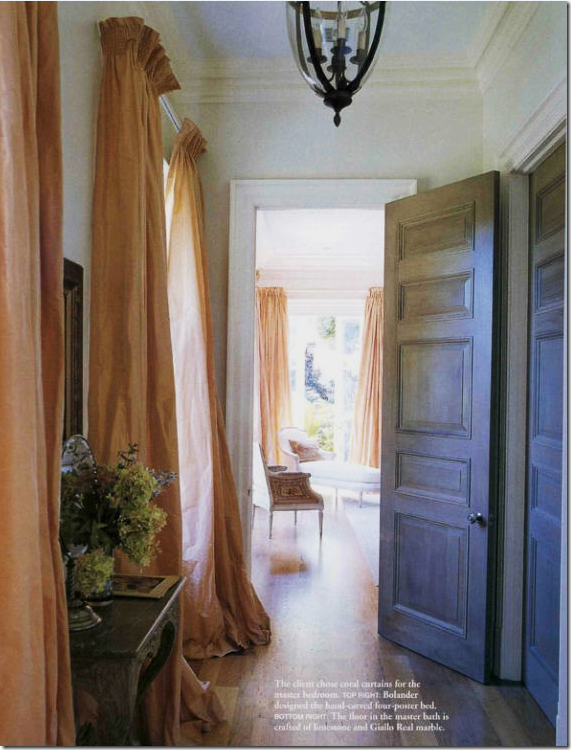





 I prefer to handle bay windows like this – with a panel between each window. It makes for less of a large expanse of windows, especially when the trim is painted a different color than the walls.
I prefer to handle bay windows like this – with a panel between each window. It makes for less of a large expanse of windows, especially when the trim is painted a different color than the walls. 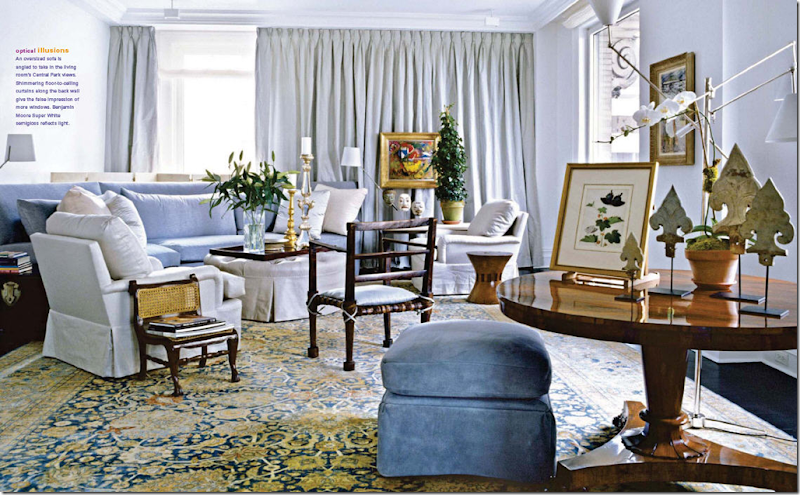

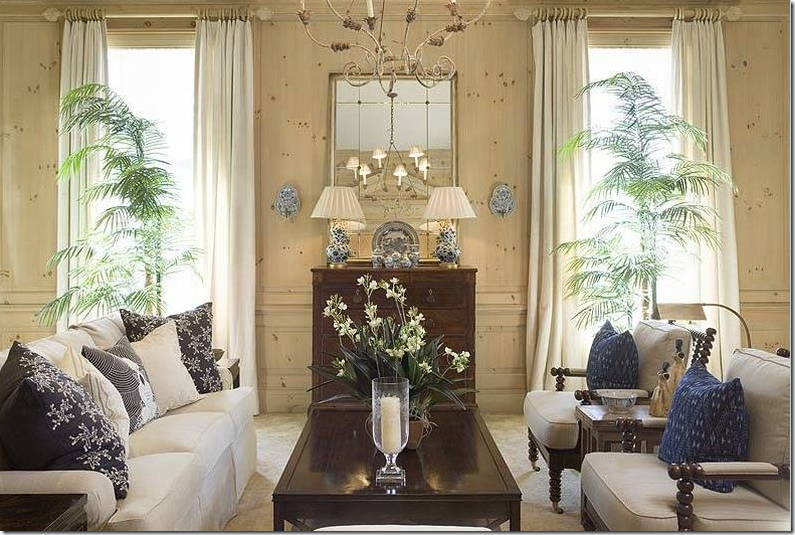

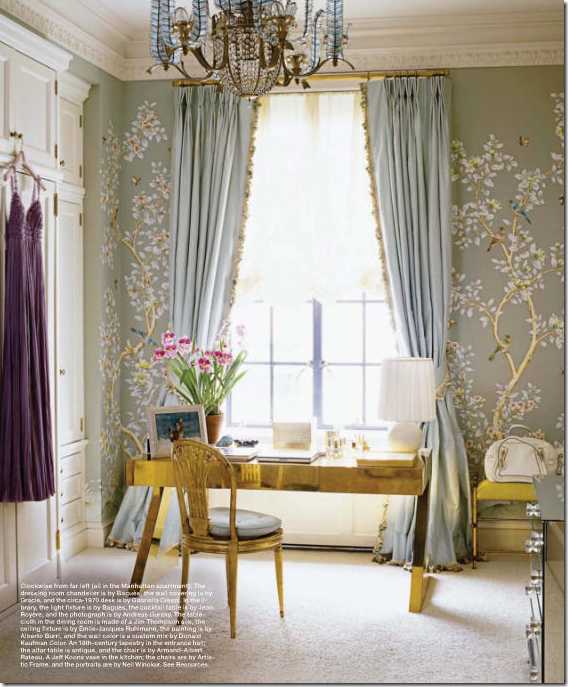








 ‘Nate Berkus’ Chicago apartment – imagine this room without the blue panels – wouldn’t quite have the same punch as it does now.
‘Nate Berkus’ Chicago apartment – imagine this room without the blue panels – wouldn’t quite have the same punch as it does now.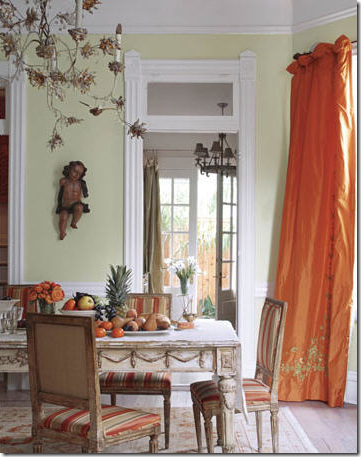
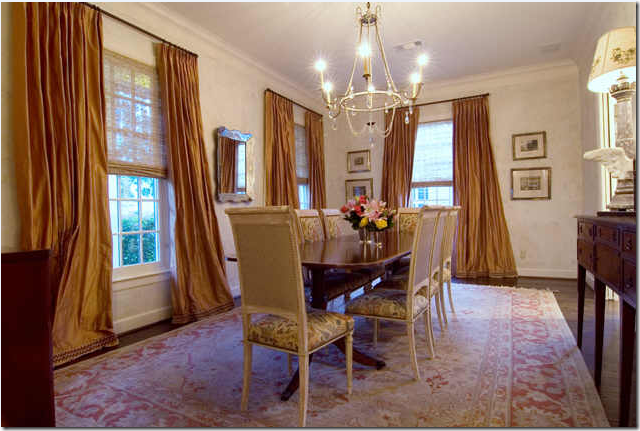
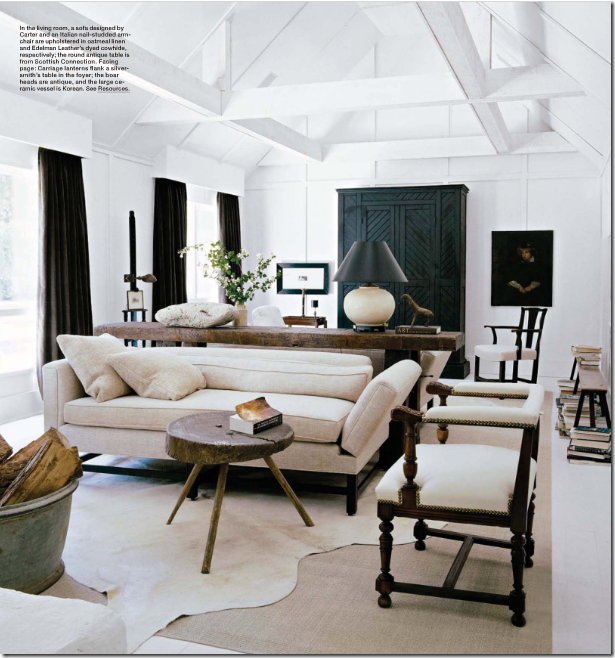 Washington DC interior designer Darryl Carter used deep chocolate panels to contrast with his signature white fabrics and dark woods. The contrast of the curtains truly gives the room its punch.
Washington DC interior designer Darryl Carter used deep chocolate panels to contrast with his signature white fabrics and dark woods. The contrast of the curtains truly gives the room its punch.
 One of Michael Smith’s first national splashes was with this living room and the gorgeous saffron curtains. Let me repeat, gorgeous!
One of Michael Smith’s first national splashes was with this living room and the gorgeous saffron curtains. Let me repeat, gorgeous!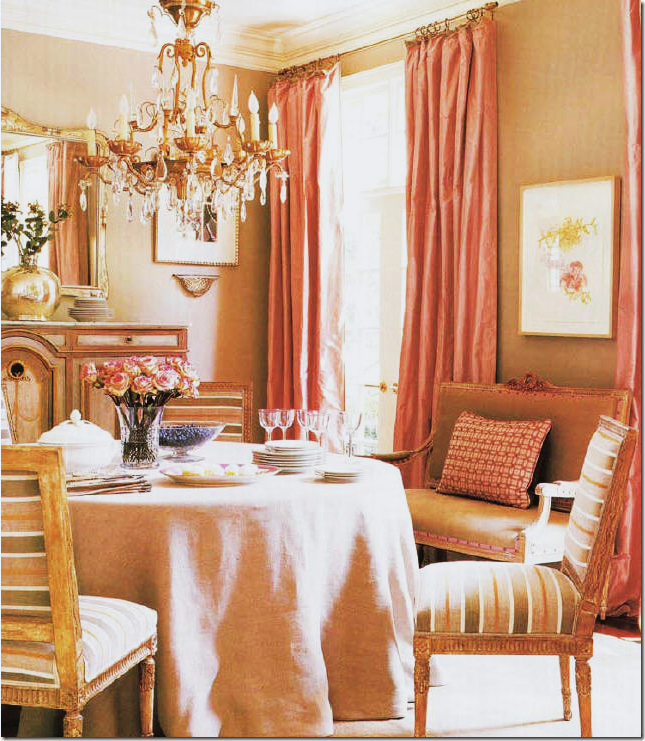 Suzanne Kasler’s dining room is beige with warm pink silk taffeta panels. The unusual color scheme came from the stripes in the chair fabric.
Suzanne Kasler’s dining room is beige with warm pink silk taffeta panels. The unusual color scheme came from the stripes in the chair fabric.



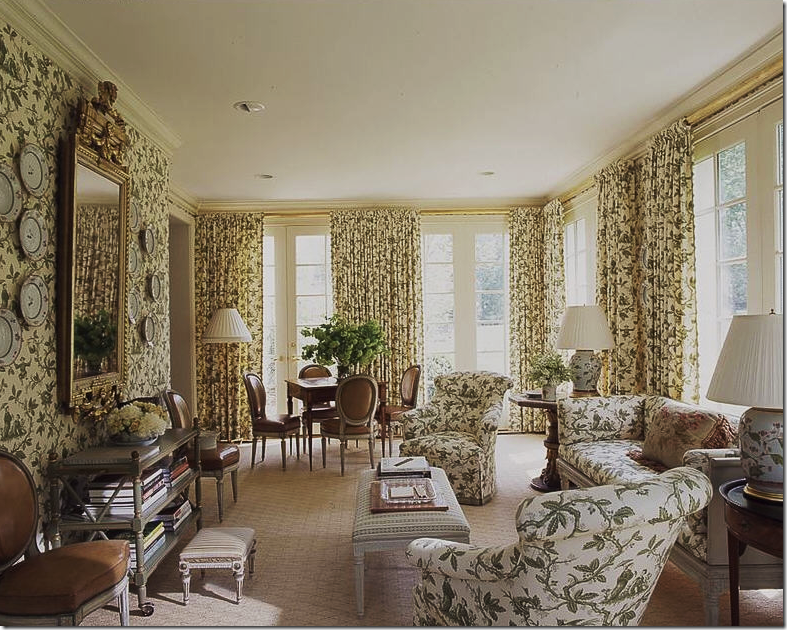
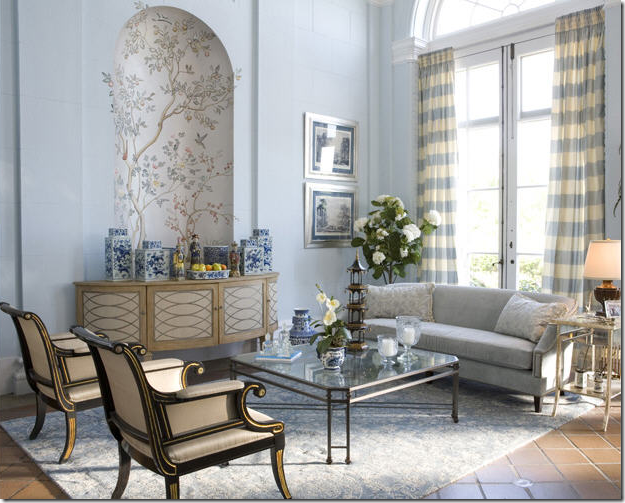
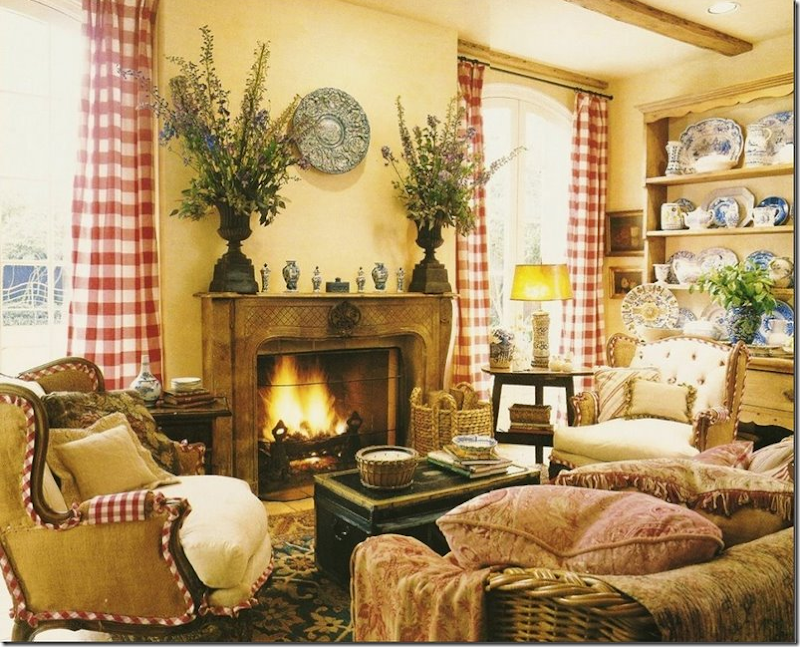

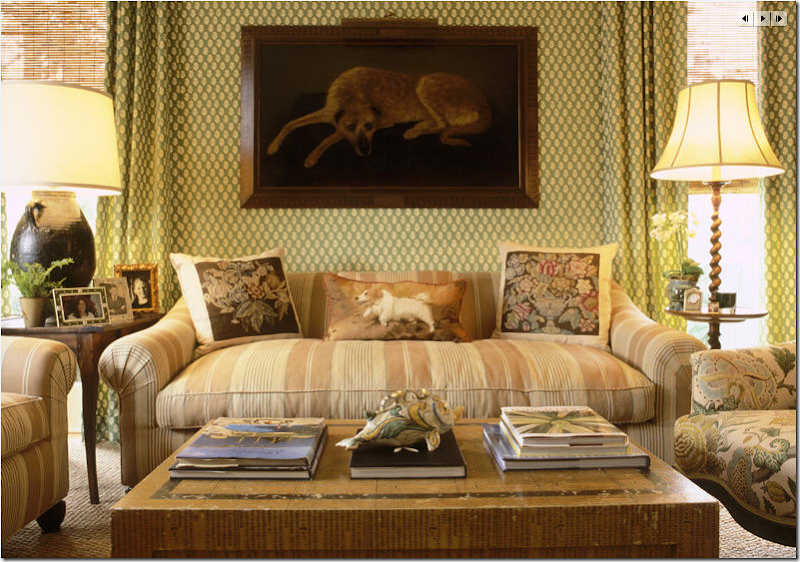


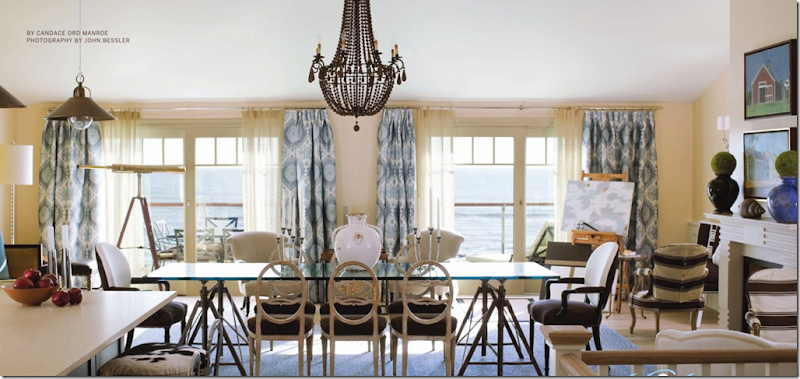
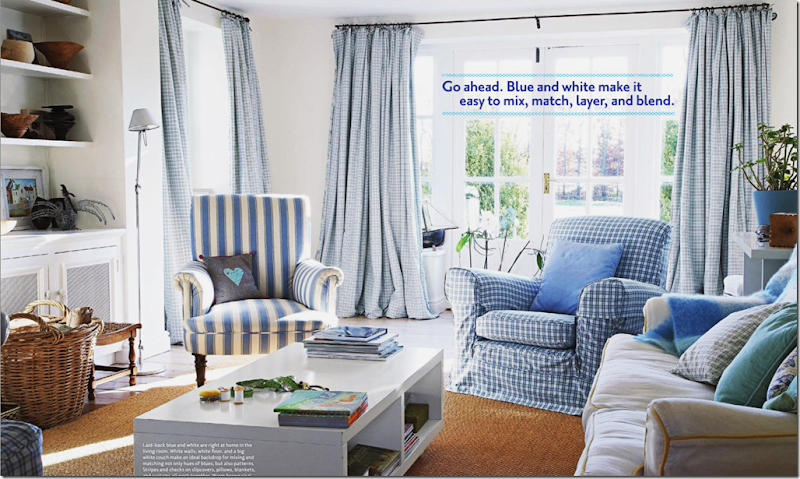
 A great looking kitchen is softened with toile panels. I love patterned fabric curtains in the kitchen.
A great looking kitchen is softened with toile panels. I love patterned fabric curtains in the kitchen.
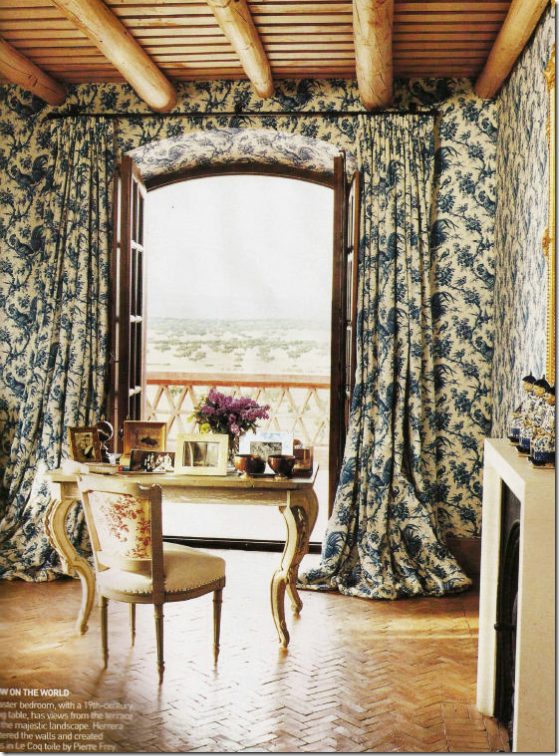

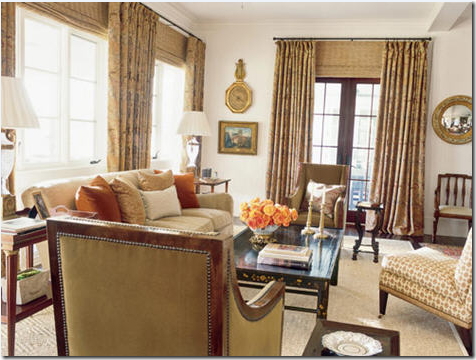 I love to use blinds, especially woven ones, with drapery panels. This is a good example of that. Here Suzanne Kasler handles this room beautifully – the blinds add a texture to the room that is especially visually pleasing and even necessary. Kasler takes the major colors from the curtain fabric and makes pillows out of them for extra color pop. One chair wears an accent fabric, the rest are neutrals. The sisal rug calms the room. I love this – it’s elegant yet friendly and inviting and not stuffy. See more of the room below:
I love to use blinds, especially woven ones, with drapery panels. This is a good example of that. Here Suzanne Kasler handles this room beautifully – the blinds add a texture to the room that is especially visually pleasing and even necessary. Kasler takes the major colors from the curtain fabric and makes pillows out of them for extra color pop. One chair wears an accent fabric, the rest are neutrals. The sisal rug calms the room. I love this – it’s elegant yet friendly and inviting and not stuffy. See more of the room below: The other side of the above room. In this section a rug replaces the sisal, providing extra pattern to the area where the curtains are absent. Look how pretty that wall of windows is with the four panels instead of just two, and the addition of the textured blinds finishes it all off. Beautiful!
The other side of the above room. In this section a rug replaces the sisal, providing extra pattern to the area where the curtains are absent. Look how pretty that wall of windows is with the four panels instead of just two, and the addition of the textured blinds finishes it all off. Beautiful!

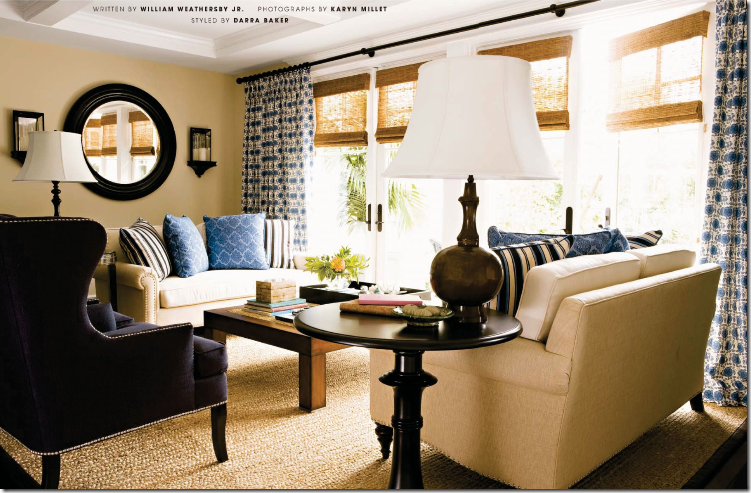
 In this Italian styled apartment, Alessandra Branca again uses Italian Stringing to great effect, adding the tortoise shell blinds for extra texture.
In this Italian styled apartment, Alessandra Branca again uses Italian Stringing to great effect, adding the tortoise shell blinds for extra texture. 



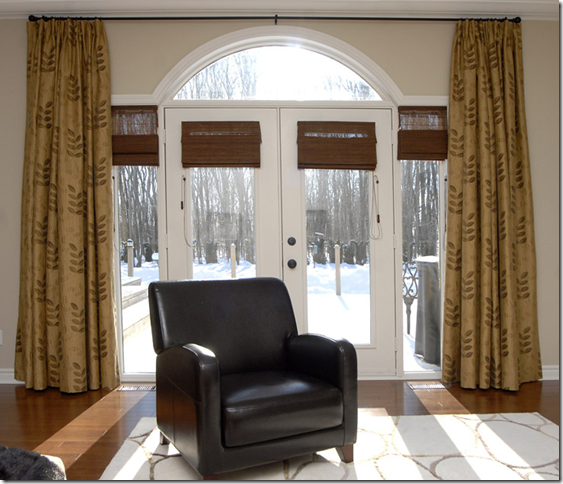



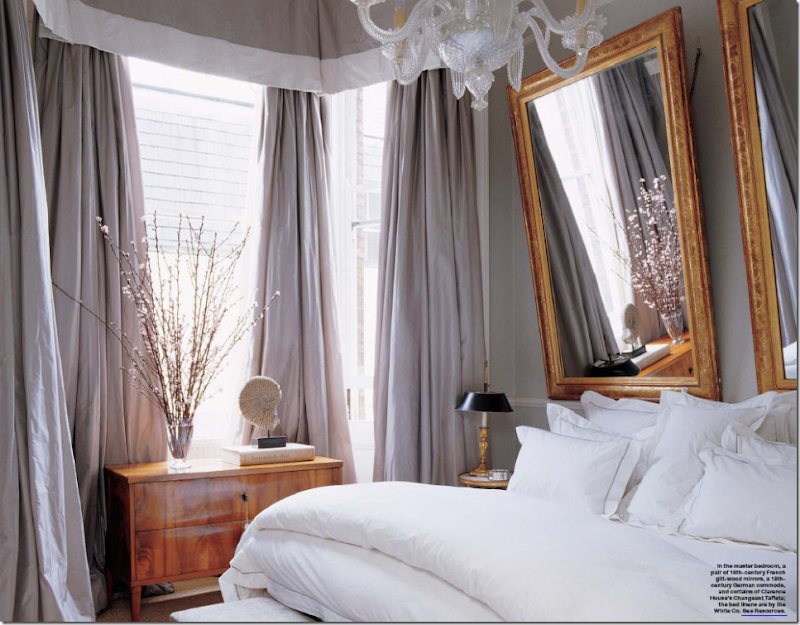 A soft valance with a wide white band and luscious, full, blowsy taffeta panels. The two mirrors for headboards are to die for. Notice how the Biedermeier chest picks up the same warm tones of the mirror – and how beautiful it looks against the cool tones of the icy blue silk. Absolutely romantic AND gorgeous!!!!!!!!!!!! NOTE: to hang mirrors to reflect downward, instead of upward – use a chain. You can see the chain used here that causes the mirror to lean forward. This is a perfect way to hang a mirror above a mantel. If the mirror is hung normally, you will get a reflection of the ceiling. This way, you get the reflection of the room itself.
A soft valance with a wide white band and luscious, full, blowsy taffeta panels. The two mirrors for headboards are to die for. Notice how the Biedermeier chest picks up the same warm tones of the mirror – and how beautiful it looks against the cool tones of the icy blue silk. Absolutely romantic AND gorgeous!!!!!!!!!!!! NOTE: to hang mirrors to reflect downward, instead of upward – use a chain. You can see the chain used here that causes the mirror to lean forward. This is a perfect way to hang a mirror above a mantel. If the mirror is hung normally, you will get a reflection of the ceiling. This way, you get the reflection of the room itself. 
 Indienne hand blocked fabric is made into panels with a valance and was also used for the upholstery. Phoebe Howard
Indienne hand blocked fabric is made into panels with a valance and was also used for the upholstery. Phoebe Howard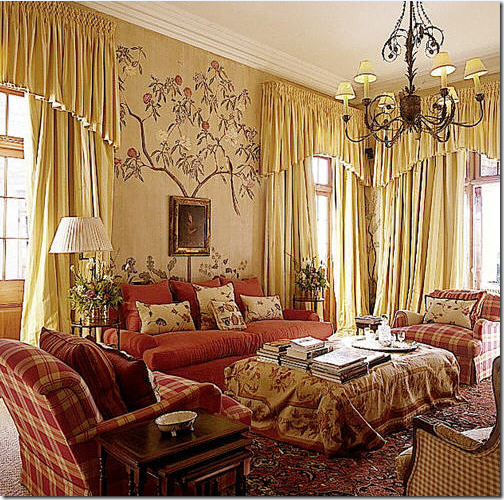 Soft smocked valances are aired with full panels in this beautiful room. I love the mural and the rug made into an ottoman. These curtains really make a statement and add so much to the room – exactly what curtains should do!
Soft smocked valances are aired with full panels in this beautiful room. I love the mural and the rug made into an ottoman. These curtains really make a statement and add so much to the room – exactly what curtains should do!

 A beautiful, colorful, fun living room for a young family with curtains made out of my favorite Raoul Textiles fabric in yellow. Timothy Whealon.
A beautiful, colorful, fun living room for a young family with curtains made out of my favorite Raoul Textiles fabric in yellow. Timothy Whealon.
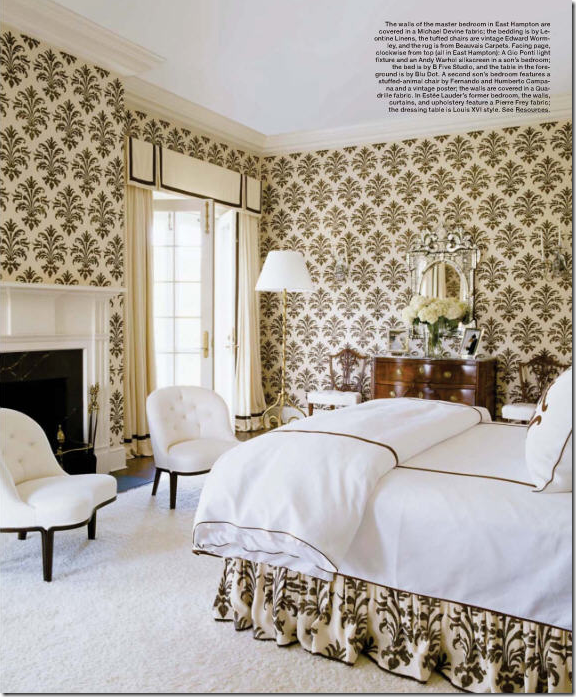 Blog favorite, Michael Devine’s fabric was matched with a valance crisply piped in black trim. So pretty!
Blog favorite, Michael Devine’s fabric was matched with a valance crisply piped in black trim. So pretty!



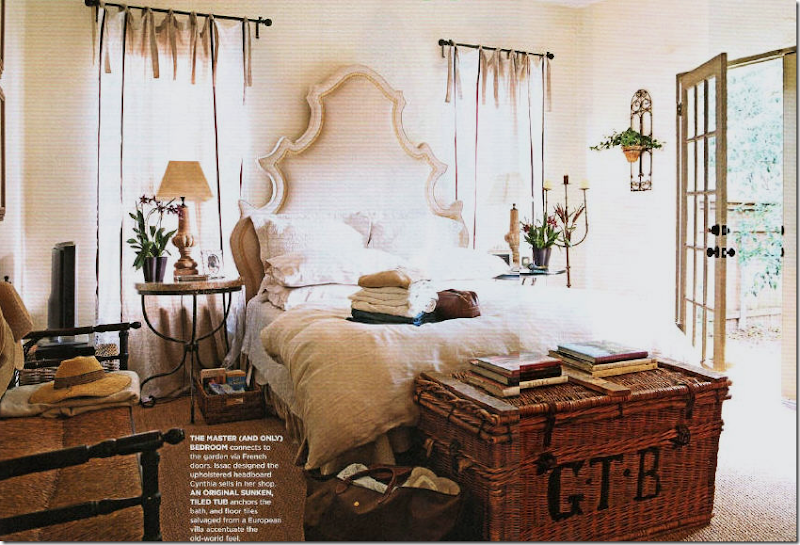
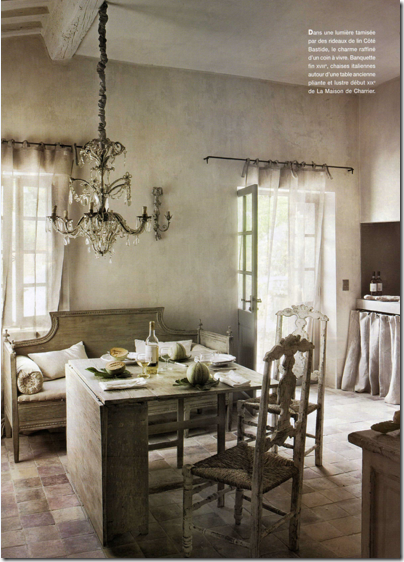

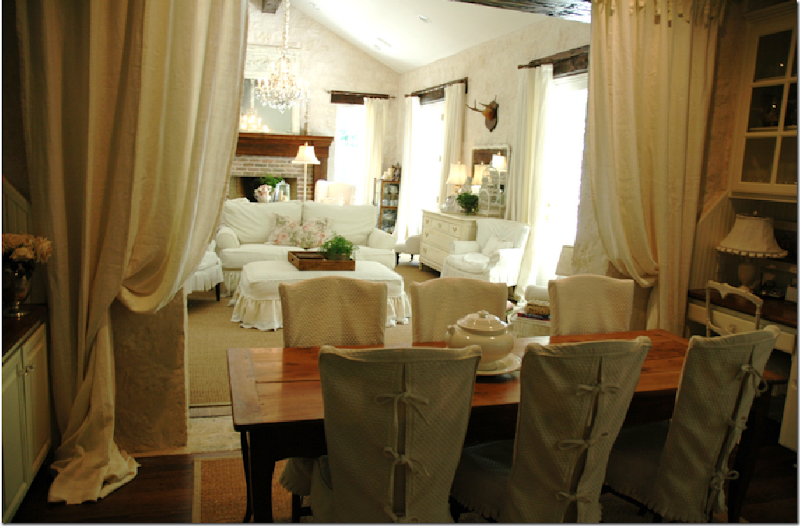

Plum pink silk is paired with khaki in this portiere that adds just a touch of romance. Truly, not much is more romantic than fabric doors!

Houston interior designer Pam Pierce used portieres to cover her bookshelves, what is a great idea if you want to soften a book laden room.


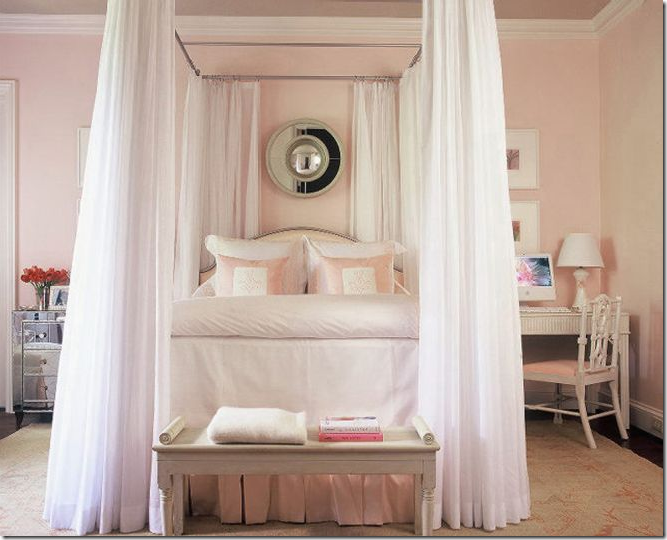



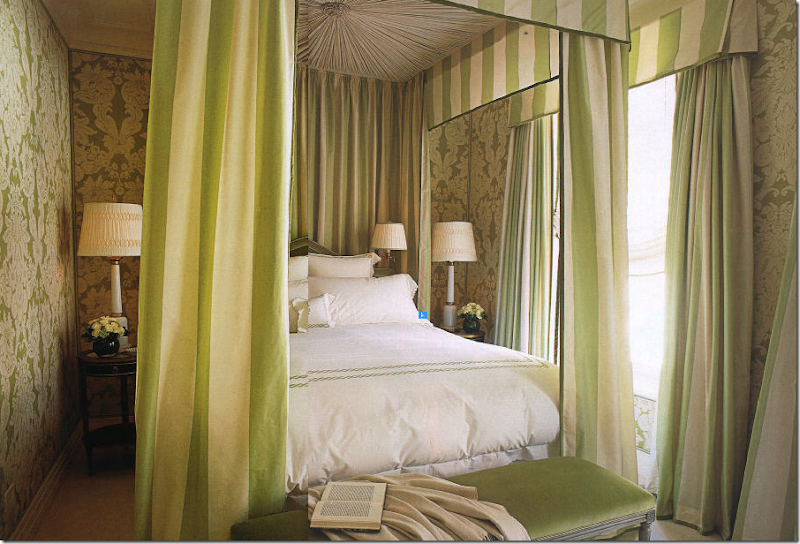




Alessandra Branca uses Roman shades made out of striped taffeta silk. The chandelier and chairs are so beautiful – the entire dining nook is!



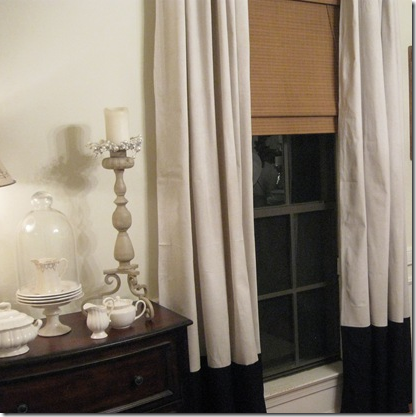


 In my living room – I have six windows – it’s not quite double height, but the room is still very tall. To disguise all the cheap windows I put four long panels of a silk ticking fabric in pale gold. The curtains drastically changed the look of the room – warming it up, making it feel cozy, and still adding an air of sophistication, forever convincing me that it’s almost always better to have curtains than not.
In my living room – I have six windows – it’s not quite double height, but the room is still very tall. To disguise all the cheap windows I put four long panels of a silk ticking fabric in pale gold. The curtains drastically changed the look of the room – warming it up, making it feel cozy, and still adding an air of sophistication, forever convincing me that it’s almost always better to have curtains than not.

